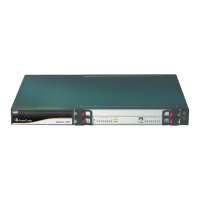User's Manual 532 Document #: LTRT-89730
Mediant 3000
message with Facility IE containing an MWI Activate request, which includes the new
number of voice messages waiting for the user. The device forwards this information
to the softswitch by sending a SIP NOTIFY.
Depending on PBX support, the MWIInterrogationType parameter can be configured
to handle these MWI Interrogation messages in different ways. For example, some
PBXs support only the MWI Activate request (and not MWI Interrogation request).
Some support both these requests. Therefore, the device can be configured to disable
this feature or enable it with one of the following support:
• Responds to MWI Activate requests from the PBX by sending SIP NOTIFY MWI
messages (i.e., does not send MWI Interrogation messages).
• Send MWI Interrogation message, but don't use its result. Instead, wait for MWI
Activate requests from the PBX.
• Send MWI Interrogation message, use its result, and use the MWI Activate
requests.
27.5 Emergency E911 Phone Number Services
This section describes the device's support for emergency phone number services.
27.5.1 Pre-empting Existing Calls for E911 IP-to-Tel Calls
If the device receives an E911 call from the IP network destined to the Tel, and there are
unavailable channels (e.g., all busy), the device terminates one of the calls (arbitrary) and
then sends the E911 call to that channel. The preemption is done only on a channel
pertaining to the same Trunk Group for which the E911 call was initially destined and if the
channel select mode (configured by the ChannelSelectMode parameter) is set to a value
other than “By Dest Phone Number” (0).
The preemption is done only if the incoming IP-to-Tel call is identified as an emergency
call. The device identifies emergency calls by one of the following:
The destination number of the IP call matches one of the numbers defined by the
EmergencyNumbers parameter. For E911, you must defined the parameter with the
value "911".
The Priority header of the incoming SIP INVITE message contains the “emergency”
value.
Emergency pre-emption of calls can be enabled for all calls, using the global parameter
CallPriorityMode, or for specific calls using the Tel Profile parameter CallPriorityMode.
Notes:
• This feature is applicable to CAS and ISDN interfaces.
• For Trunk Groups configured with call preemption, all must be configured to MLPP
[1] or all configured to Emergency [2]. In other words, you cannot set some trunks
to [1] and some to [2].
• The global parameter must be set to the same value as that of the Tel Profile
parameter; otherwise, the Tel Profile parameter is not applied.
• If you configure call preemption using the global parameter and a new Tel Profile
is subsequently added, the TelProfile_CallPriorityMode parameter automatically
acquires the same setting as well.

